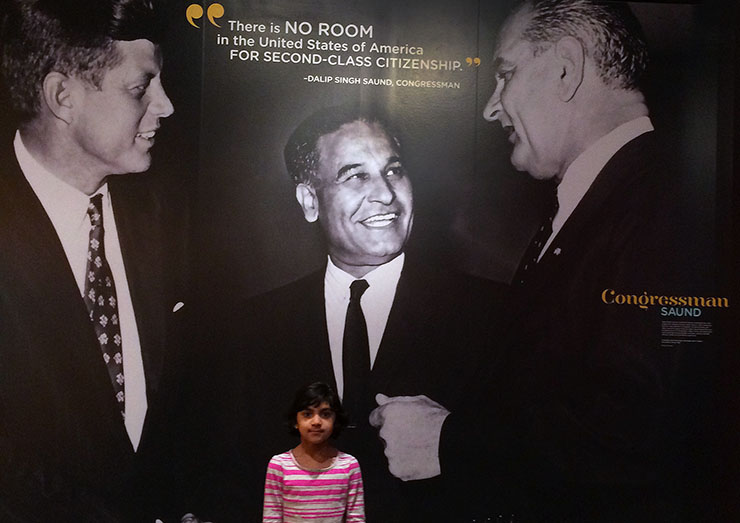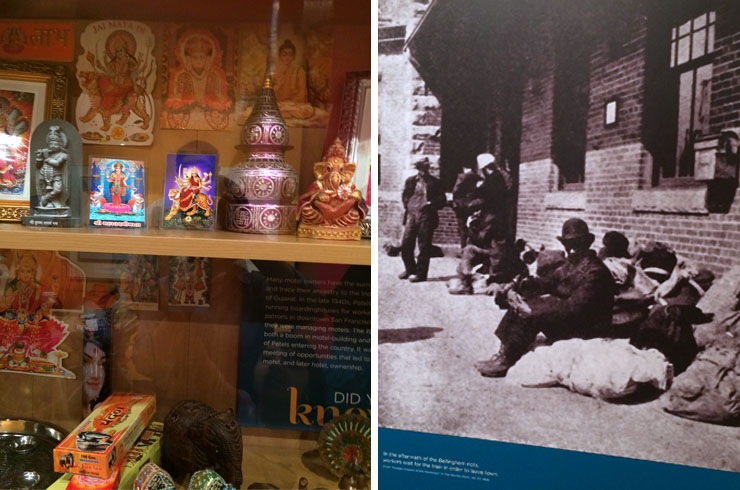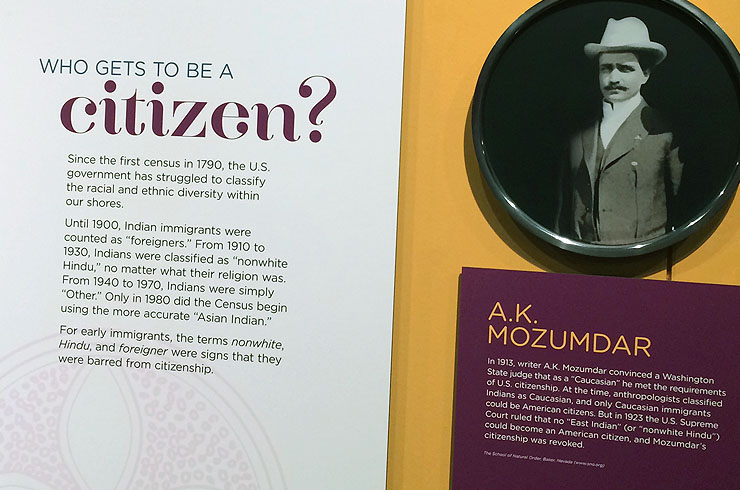Modern Reston is excited to present our next guest post! From time to time, we’ll hand the mic to others in our community who have something interesting to say. Please feel free to submit your ideas here.
Please give your undivided attention to Reston Resident Shefali Chandan as she explores the current Smithsonian exhibit Beyond Bollywood: Indian Americans Shape the Nation.
“Desis” in America – The Smithsonian captures early immigrant struggles and the impact of Indian immigrants to the United States.
By Shefali K. Chandan
A special exhibit on Asian Indians in America — Beyond Bollywood: Indian Americans Shape the Nation — has been on display since February at the Smithsonian’s Museum of Natural History in Washington DC. Tucked away in one of the galleries adjacent to the permanent collection from Korea, visitors are greeted by familiar Bollywood melodies. As you walk in you may be welcomed by the lyrics “jeena yahan, marna yahan, iske siva jaana kahan” (“we have to live here, we will die here, where else can we go apart from here?”) from Bollywood director Raj Kapoor’s famous movie, Mera Naam Joker. While in the movie, the verse was a refrain on life in general, the words could well have been written to express the sentiments of Indian immigrants to the U.S. or indeed of all those who over centuries have journeyed to America and made it their home.
3.3 million Indians live in America, which is only 1% of the U.S. population. (Approximately 45,000 Asian Indians make Fairfax county their home and nearly 25,000 Indians live in nearby Loudon county. The Washington D.C. area is home to the fourth largest concentration of Indians in the county). This small number belies the depth and range of the community’s contributions to their adopted homeland. Demonstrating this diversity is the main thrust of the exhibit. Displayed on the mustard and crimson walls of the gallery are eye-catching statistics – 10% of Indians in America are doctors; 50% of all motels are owned by Indians; 73% of National Spelling Bee winners since 1999 have been Indian and 15% of all start-ups in Silicon Valley have Indian founders. Juxtaposed with these statistics are less well-known facts. Indian Americans it turns out are also hip-hop musicians, football players, fashion designers and farmers. The exhibit is ambitious in it’s scope, displaying artifacts such as Michelle Obama’s gown for the 2012 Governor’s Ball designed by Indian-American Naeem Khan; the original Pentium chip invented by Indian scientist Vinod Dham; a recreated motel reception kiosk and a yoga canopy.

Shefali’s daughter poses in front of this moving quote by Dalip Singh Saund.
The relatively small numbers of Indians who make America their home has meant that the particular experience of Indian American immigrants has been largely unchronicled in the mainstream. “Desis” (as Indians often refer to each other) themselves may not be surprised by the information at the exhibit, usually covered in greater detail by ethnic newspapers and TV shows. Who within the community doesn’t know about the preponderance of Indian kids in spelling bees or the large numbers of Indian teens in pre-med courses. Nor are the outliers and community mavericks — Night Shymalan the Hollywood film maker or Naeem Khan the fashion designer — unknown to most of us. But to see the entire range of the Indian American saga at a prominent venue like the Smithsonian, now visible to folks outside the community is a happy new development for Indian Americans. And then there are some things that only the Smithsonian could have pulled off for visitors, like displaying the actual gown worn by the first lady or showcasing the helmet worn by an Indian American NFL player (one of only 2 Indians in the NFL ever).
One wall of the exhibit touches upon early Indian immigration. The Indian immigration story usually focuses on accomplishments by Indian professionals and entrepreneurs and their relatively easy passage to the United States after the Immigration Act of 1965. Indeed 1965 was the turning point for Asian, Latino & African immigration to the U.S. and the 1965 law signed by President Nixon virtually changed the face of America. However, between 1899 and 1910, about 4,713 Indian immigrants came by ship to North America’s Pacific Coast. This number increased to 6,795 by the year 1920. While by no means a large number, reactions to the arriving Indians (mostly Sikh and working class) soon became hostile, violent and finally led to the passage of exclusionary immigration laws. Indians too like the Chinese, Japanese and Koreans before them became the target of local labor unions which previously had influenced the passage of the Chinese Exclusion Act. They now worked to extend the Chinese Exclusion Act to all Asians. Eventually the “Asiatic Barred Zone” Act of 1917 that barred entry to almost all Asians including Indians was passed. This history is largely unknown even to most Indians.

Left, the altar at a typical reception kiosk of a motel owned by Indians. Right, workers waiting to leave town after the Bellingham Riots.
In one corner of the exhibit hall, a short video plays every few minutes. The video includes footage from a 2004 documentary about Sikh cab drivers in San Francisco. In the documentary, one cab driver exclaims
“To leave your country and come over here, it’s not a small decision you know. Nobody makes a small decision. It is a very, very strong decision.”
Perhaps he meant it’s a tough decision. It is tough as many of us know and it takes strength making it in America despite it’s many opportunities. Which makes the accomplishments of the Indian Americans featured in the exhibit all the more extraordinary.
Beyond Bollywood: Indian Americans Shape the Nation will be on display at the National Museum of Natural History in Washington, D.C. until August, 2015. The exhibition explores the heritage, daily experience and numerous, diverse contributions that Indian immigrants and Indian Americans have made to shaping the United States.
Shefali Chandan is an educator and entrepreneur. She is an adjunct professor at Marymount University in Washington DC and is the founder & CEO of Gnana, an education technology company targeted to Indian teenagers. She may be reached at: [email protected]

